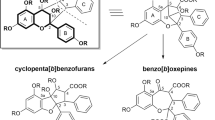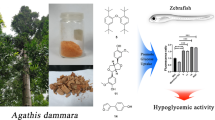Abstract
Two new naphthalenic lactone glycosides, (3S)-9,10-dihydroxy-7-methoxy-3-methyl-1-oxo-3,4-dihydro-1H-benzo[g]isochromene-3-carboxylic acid 9-O-β-d-glucopyranoside (1) and (3R)-cassialactone 9-O-β-d-glucopyranoside (2) were isolated from seeds of Cassia obtusifolia Linn., along with five known compounds: (3R)-cassialactone 9-O-β-d-gentiobioside (3), emodin 1-O-β-gentiobioside (4), 1-hydroxyl-2-acetyl-3,8-dimethoxy-naphthalene 6-O-β-d-apiofuranosyl-(1 → 2)-β-d-glucopyranoside (5), rubrofusarin 6-O-β-d-gentiobioside (6), rubrofusarin 6-O-β-d-triglucoside (7). Structures of 1 and 2 were elucidated by NMR and HR-ESI-MS spectroscopic analysis. Their stereochemistry was determined by CD experiment. All compounds were tested for their ability to inhibit the formation of advanced glycation end-products in vitro. Compounds 1, 2, 3, 5, and 6 showed significant in vitro inhibitory activities (IC50 values of 11.63, 23.40, 7.32, 89.03, and 38.89 µM, respectively).


Similar content being viewed by others
References
Abo KA, Lasaki SW, Adeyemi AA (1999) Laxative and antimicrobial properties of Cassia species growing in Ibadan. Niger J Nat Prod Med 3:47–50
Ahmed N (2005) Advanced glycation endproducts-role in pathology of diabetic complications. Diabetes Res Clin Pract 67:3–21
Ayer WA, Craw PA, Nozawa K (1991) Two 1H-naphtho [2, 3-c] pyran-1-one metabolites from the fungus Paecilomyces variotii. Can J Chem 69:189–191
Baynes JW (2001) The role of AGEs in aging: causation or correlation. Exp Gerontol 36:1527–1537
Bhakta T, Mukherjee PK, Saha K, Pal M, Saha BP (1997) Hypoglycemic activity of Cassia fistula Linn. (Leguminosae) leaf (methanol extract) in alloxan-induced diabetic rats. J Ethnobot 9:35–38
Choi JS, Jung JH, Lee HJ, Kang SS (1996) The NMR assignments of anthraquinones from Cassia tora. Arch Pharm Res 19:302–306
Drever BD, Anderson WG, Riedel G, Kim DH, Ryu JH, Choi DY, Platt B (2008) The seed extract of Cassia obtusifolia offers neuroprotection to mouse hippocampal cultures. J Pharmacol Sci 107:380–392
Hatano T, Uebayashi H, Ito H, Shiota S, Tsuchiya T, Yoshida T (1999) Phenolic constituents of Cassia seeds and antibacterial effect of some naphthalenes and anthraquinones on methicillin-resistant Staphylococcus aureus. Chem Pharm Bull 47:1121–1127
Hennebelle T, Weniger B, Joseph H, Sahpaz S, Bailleul F (2009) Senna alata. Fitoterapia 80:385–393
Jang DS, Lee GY, Kim YS, Lee YM, Kim CS, Yoo JL, Kim JS (2007) Anthraquinones from the seeds of Cassia tora with inhibitory activity on protein glycation and aldose reductase. Biol Pharm Bull 30:2207–2210
Ju MS, Kim HG, Choi JG, Ryu JH, Hur J, Kim YJ, Oh MS (2010) Cassiae semen, a seed of Cassia obtusifolia has neuroprotective effects in Parkinson’s disease models. Food Chem Toxicol 48:2037–2044
Jung HA, Ali MY, Jung HJ, Jeong HO, Chung HY, Choi JS (2016) Inhibitory activities of major anthraquinones and other constituents from Cassia obtusifolia against β-secretase and cholinesterases. J Ethnopharmacol 191:152–160
Jung HA, Ali MY, Choi JS (2017) Promising inhibitory effects of anthraquinones, naphthopyrone, and naphthalene glycosides, from Cassia obtusifolia on α-glucosidase and human protein tyrosine phosphatases 1B. Molecules 22:28
Kim YM, Lee CH, Kim HG, Lee HS (2004) Anthraquinones isolated from Cassia tora (Leguminosae) seed show an antifungal property against phytopathogenic fungi. J Agric Food Chem 52:6096–6100
Kitanaka S, Takido M (1981) Studies on the constituents of the seeds of Cassia obtusifolia: the structures of two new lactones, isotoralactone and cassialactone. Phytochemistry 20:1951–1953
Kitanaka S, Takido M (1986) Studies in the constituents of the root of Cassia obtusifolia L. and the antimicrobial activities of constituents of the roots and seeds. Yakugaku Zasshi 106:302–306
Kitanaka S, Ogata K, Takido M (1990) Revision of the structure and absolute configuration of cassialactone. Phytochemistry 29:999–1002
Lee GY, Jang DS, Lee YM, Kim JM, Kim JS (2006) Naphthopyrone glucosides from the seeds of Cassia tora with inhibitory activity on advanced glycation end products (AGEs) formation. Arch Pharm Res 29:587–590
Nguyen DH, Seo UM, Zhao BT, Le DD, Seong SH, Choi JS, Min BS, Woo MH (2017) Ellagitannin and flavonoid constituents from Agrimonia pilosa Ledeb. with their protein tyrosine phosphatase and acetylcholinesterase inhibitory activities. Bioorg Chem 72:293–300
Rader DJ (2007) Effect of insulin resistance, dyslipidemia, and intra-abdominal adiposity on the development of cardiovascular disease and diabetes mellitus. Am J Med 120:S12–S18
Shrestha S, Seong SH, Paudel P, Jung HA, Choi JS (2018) Structure related inhibition of enzyme systems in cholinesterases and BACE1 in vitro by naturally occurring naphthopyrone and its glycosides isolated from Cassia obtusifolia. Molecules 23:69
Sob SV, Wabo HK, Tchinda AT, Tane P, Ngadjui BT, Ye Y (2010) Anthraquinones, sterols, triterpenoids and xanthones from Cassia obtusifolia. Biochem Syst Ecol 38:342–345
Vinson JA, Howard TB III (1996) Inhibition of protein glycation and advanced glycation end products by ascorbic acid and other vitamins and nutrients. J Nutr Biochem 7:659–663
Vitek MP, Bhattacharya K, Glendening JM, Stopa E, Vlassara H, Bucala R, Manogue K, Cerami A (1994) Advanced glycation end products contribute to amyloidosis in Alzheimer disease. Proc Natl Acad Sci USA 91:4766–4770
Wang ZJ, Wu QP, Tang LY, Fu MH, He Y, Gong QF, Huang LQ (2007) Two new glycosides from the genus of Cassia. Chin Chem Lett 18:1218–1220
Yada H, Sato H, Toshima H, Deura M, Ichihara A (2001) (−)-Semivioxanthin, a new abscisic active compound against Hinoki cypress leaves isolated from Cryptosporiopsis abietina. Biosci Biotechnol Biochem 65:484–486
Yen GC, Chuang DY (2000) Antioxidant properties of water extracts from Cassia tora L. in relation to the degree of roasting. J Agric Food Chem 48:2760–2765
Yi JH, Park HJ, Lee S, Jung JW, Kim BC, Lee YC, Ryu JH, Kim DH (2016) Cassia obtusifolia seed ameliorates amyloid β-induced synaptic dysfunction through anti-inflammatory and Akt/GSK-3β pathways. J Ethnopharmacol 178:50–57
Youn IS, Han AR, Choi JS, Seo EK (2017) A new naphthalenic lactone glycoside from the seeds of Cassia obtusifolia. Chem Nat Compd 53:429–431
Zhang C, Wang R, Liu B, Tu G (2011) Structure elucidation of a sodium salified anthraquinone from the seeds of Cassia obtusifolia by NMR technique assisted with acid–alkali titration. Magn Reson Chem 49:529–532
Acknowledgements
This research was supported by the Basic Science Research Program through the National. Research Foundation of Korea (NRF), and funded by the Ministry of Science, ICT & Future Planning (2015R1D1A1A01057156).
Author information
Authors and Affiliations
Corresponding authors
Ethics declarations
Conflicts of interest
The authors declare that there are no conflicts of interest.
Rights and permissions
About this article
Cite this article
Shrestha, S., Paudel, P., Seong, S.H. et al. Two new naphthalenic lactone glycosides from Cassia obtusifolia L. seeds. Arch. Pharm. Res. 41, 737–742 (2018). https://doi.org/10.1007/s12272-018-1044-0
Received:
Accepted:
Published:
Issue Date:
DOI: https://doi.org/10.1007/s12272-018-1044-0




